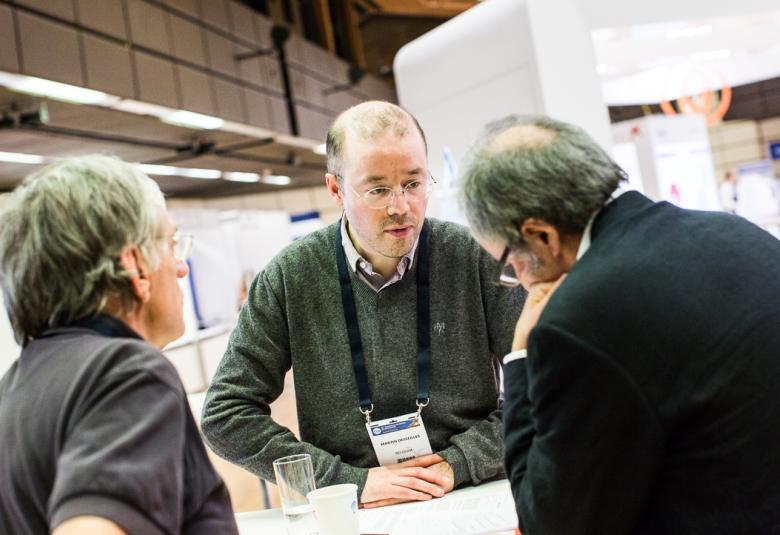Despite the availability of effective antipsychotic medications for decades, significant numbers of patients with schizophrenia still have poor outcomes. Although antipsychotic medications are the first-line treatment option for patients with first-episode schizophrenia (FES), many questions remain about their use. During SIRS 2018 data from OPTiMiSE (Optimisation of Treatment and Management of Schizophrenia in Europe) – a European consortium specifically constituted to address these questions – released its initial findings about switching between antipsychotic medications in patients who failed to remit.
Investigating switching antipsychotics in first episode schizophrenia
The OPTiMiSE consortium’s principal investigator, Rene Kahn, New York, USA, described the clinical study undertaken to investigate switching medications. OPTiMiSE is a large study – incorporating 27 centers in 14 countries. Overall, 446 of the 481 patients recruited were eligible to enter.
During Phase I of the study, all patients received a D2/D3 receptor antagonist. Those patients not achieving remission after 4 weeks, were randomized either to remain on the same D2/D3 receptor antagonist or to switch to another in the same class (Phase II). Those not achieving remission after 6 weeks were then switched to an antipsychotic medication with a different receptor profile and assessed after 12 weeks (Phase III). Remission was assessed using the Andreasen criteria (without the duration requirement).
Demographics
Patients were generally young (mean age 26 years), predominantly male and Caucasian. Total PANSS scores were in-line with those seen in other populations with schizophrenia (mean 78 ± 18.7). Over 50% of patients were treatment naïve. Of the remainder, prior antipsychotic medication for a period of no longer than two weeks in the previous year and/or 6 weeks total in their lifetime was permitted. Thus, patients were relatively unexposed to prior treatment with an antipsychotic medication.
Phase I of the study
A total of 371/446 patients completed Phase I; of these 250 were remitters and 121 non-remitters. Thus, a remission rate of 56% was attained after 4 weeks of treatment. Remitters and non-remitters differed at baseline; generally remitters were older, had a shorter duration of illness and a higher age at onset than non-remitters. Drop out during Phase I was 17%.
Phase II of the study
A total of 93 non-remitting patients entered Phase II of the study, 72 of whom were completers. Of these, 34% attained remission. There was no significant difference in remission rate between the different treatment arms (p=0.87) suggesting that, at least in this population, switching therapy was of no benefit. There were no differences between treatment arms that were of note other than weight gain which was statistically different in the group that switched antipsychotic therapy (p=0.021). It should, however, be noted that while the overall drop out during Phase II was 23%, the rate was 29.8% in patients who switched therapy compared to 15.2% in those that did not. This difference was not statistically significant but by this stage in the study, patient numbers were becoming low which may have influenced statistical analyses.
There was no statistically significant difference in remission rate between the different treatment arms (p=0.87) suggesting that, at least in this population, switching therapy was of no benefit
Phase III of the study
Of the 41 Phase II non-remitters, 28 entered Phase III of the study and 18 completed the 12 weeks of treatment. A total of 5/18 completers attained remission giving a Phase III remission rate of 18%. Drop out during Phase III was 36%. As Dr Kahn observed, the only problem was keeping patients on the drug.
Professor Kahn concluded by suggesting that by using a single antipsychotic agent for up to 10 weeks and subsequent use of a serotonin antagonist in Phase I and II non-remitters, remission rates of over 75% could be obtained in completers and almost 66% in those in whom treatment had been initiated. There was no need to switch medications before giving a serotonin antagonist. And, he suggested that possibly there is no need to delay switching to an agent with a different mode of action beyond 10 weeks from initiating antipsychotic therapy in those with FEP.
Remission rates of over 75% could be obtained in completers and almost 66% in those in whom treatment had been initiated
PSI investigation – added value?
OPTiMiSE also investigated the added value of psychosocial interventions to improve treatment adherence, reduce relapses and improve functional outcomes after remission is achieved. As Richard Drake, Maryland, USA, explained, a working party study recruited remitted patients from all phases of OPTiMiSE as well as some unremitted drop-out patients willing to enter the adherence study.
Following a baseline assessment, 234 patients were randomized to receive treatment as usual (TAU; n=111 at baseline) or TAU plus psychosocial interventions (PSI; n=118 at baseline). At 3 months and 12 months there were 91 and 76, respectively, patients remaining in the TAU group, and 79 and 69 in the PSI group, respectively.
PSI involved: e-learning via a psychoeducational website, a mHealth intervention with 3 months’ worth of text message medication reminders to their mobile phone and motivational interviewing (MI) targeting adherence over 6 wees.
Psychosocial interventions involved e-learning via a psychoeducational website, a mHealth intervention with text message medication reminders and motivational interviewing targeting adherence
Primary outcome measures at 3 and 12-month follow-up were Compliance Rating Scale (score 1–7 worst to best), and Social and Occupational Function Assessment Scale (SOFAS; 0–100). Secondary outcomes included remission, Drug Attitudes Inventory (DAI), and EuroQoL quality of life scale.
The feasibility of online psychoeducation and training in MI was promising. Webpages covering illness and treatment received 244 and 290 hits each. 24% of the PSI group set up SMS text message reminders. At least 70% of the patients attended motivational interviewing sessions; 77% of whom attended all sessions. Evidence of immediate, continued effect of PSI on social functioning and continued remission compared to TAU. There was an improvement in attitudes to medication in the PSI group compared to the TAU group (P<0.005). There was, however, no evidence of any effect of PSI on staff-assessed adherence, admissions, relapse, PANSS or positive symptoms compared to TAU.
No evidence of any effect of psychosocial interventions on adherence compared to treatment as usual
Is MRI scanning cost-effective?
OPTiMiSE also collected a systematic sample of 203 standardized, high-quality, magnetic resonance imaging (MRI) images at 8 selected centers. The MRI scans revealed 3 brain tumors and 4 anomalies that required further investigation. The cost effectiveness of giving all first episode psychosis patients an MRI scan remains to be determined although Philip McGuire, London, UK, stressed that the benefit to those patients with tumors detected may be incalculable. Furthermore, he believes the cost of MRI scanning will likely become more affordable in future.
More information on the OPTiMiSE trial can be found at http://www.optimisetrial.eu/




